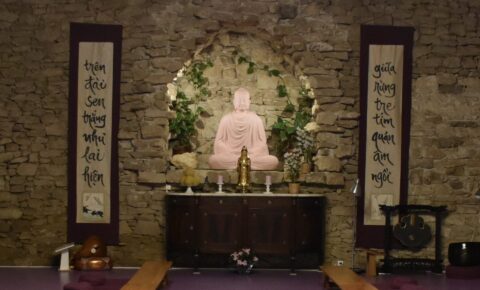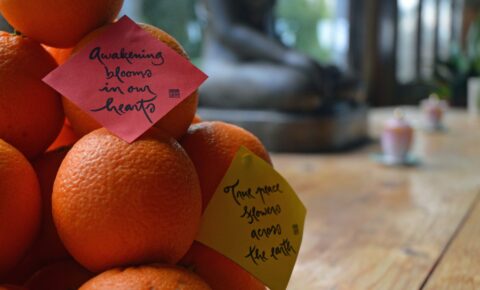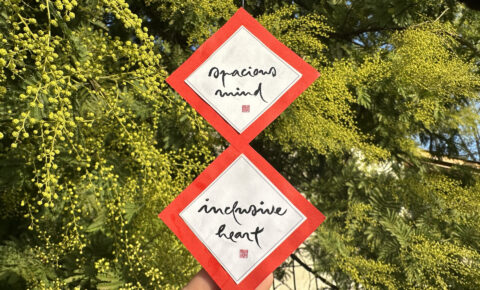Translation and commentary of another of Thich Nhat Hanh’s meditation hall Zen poems.
Our teacher Thay has offered each meditation hall at Plum Village monastery parallel verses,Parallel verses (also known as a couplet) are a form of Vietnamese poetry, each verse has the same number of words, normally ranging from four to seven. Corresponding characters also often have the same lexical category (noun-noun, verb-verb, etc.).created by his own hand. They hang on each side of the main altar and their poetic nature serves as inspiration for our practice.
For the first time, we are offering a translation of these verses from Vietnamese into English followed by a commentary from a Plum Village elder. We hope these verses will give you a small taste of the beauty of Vietnamese Zen poetry.
Still Water Meditation Hall (Upper Hamlet)
Trúc tím hoa vàng mắt chánh niệm truyền trao càng ngắm càng nhìn càng hiểu rõ Thông reo chim hót tai chân tâm tiếp thọ biết nghe biết lắng biết thương sâu. Violet bamboos, yellow flowers, eyes of mindfulness continuously transmitted, the more we gaze, the more we look, the more deeply we understand. Singing pine trees, chirping birds, ears of true mind continuously received, knowing how to listen, knowing how to be still, love deepens.

Commentary from Brother Phap Ung
The wonders of life (violet bamboos, yellow flowers, singing pine trees, chirping birds…) are always present in the here, in the now for us. With the eyes of mindfulness, ears of true mind transmitted continuously, uninterrupted by our ancestors. We can enjoy and nourish ourselves with the wonders of life in the here, in the now. We can see that ourselves and our ancestors, our descendants are always together. We inter-are! The transmission and the inheritance inter-are, never separated. Therefore, enjoying life, enjoying the present moment, appreciating, protecting life, we do it together with and for our ancestors, our beloved ones, our descendants, and all beings.
We can also discover that there is a deep link between happiness and suffering, between the lotus and the mud. By being in touch deeply with our suffering, we understand and give rise to love, and find the way out from the suffering. At the same time, when we cultivate happiness in mindfulness, we nurture ourselves, we nurture our being, we are healing our suffering at the same time. So there is an intimate relationship between happiness and suffering, suffering and happiness.
With this non-discriminative understanding, we cultivate compassion, inclusiveness, peace, and non-duality. We are capable of doing it when we cultivate the quality of our being, to be present, to be still, to look deeply, to listen deeply. We can discover that happiness and suffering are not strictly individual matters. Our well-being and our ill-being are interconnected, interrelated with our society, with our ancestors, and with our descendants. This insight will give rise to peace, stability, freedom, great compassion, and great aspiration to nourish, treasure, protect, and heal.
This is also true in terms of the relationship between human beings and other beings. The well-being and the ill-being of humans and the well-being and the ill-being of other beings are interconnected, interrelated. Therefore nourishing, protecting, supporting other beings is at the same time nourishing, protecting, supporting ourselves as human beings.
You may enjoy reading Part 1 of this article about the parallel verses of Lower Hamlet and New Hamlet here.






Share Your Reflections